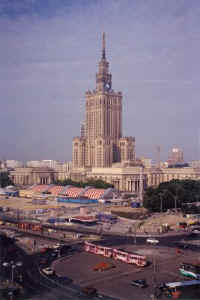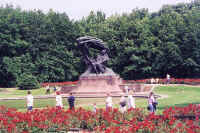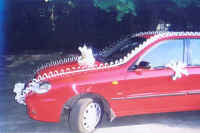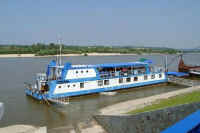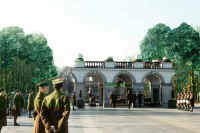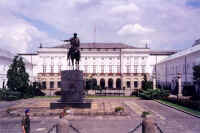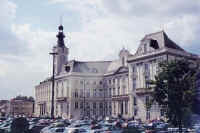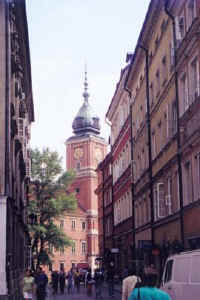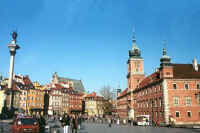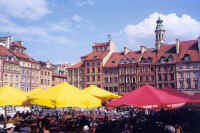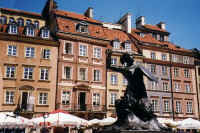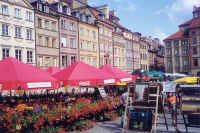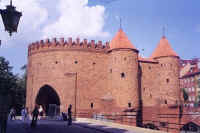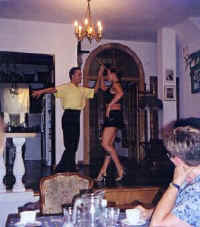|
Warsaw Friday, 17 July: We were up before 7 a.m., but it was a rocky start. In spite of all the adapters we'd brought, Jane couldn't get her hair dryer to work. I got the maid to show us where to plug it in. (You had to use one particular plug, reached by crawling under the vanity.) By that time, though, Jane said it was so late that she was going to have to skip breakfast. I went down alone at eight. The buffet line for breakfast was very poorly organized. There was only one line, no matter what you wanted, so everyone was held up by the slowest people. After a long wait, I sat down with the Kimmins brothers, Bob and Hal, because their table was right by the line approaching the buffet - just in case Jane did come. About 8:30 she did show up. The line had diminished so she was able to get some food and join us fairly quickly.
At 9 a.m. Katie gave us the tour orientation, described the optional events, and gave us a chance to
sign up for them. We signed up for everything (eight tours), at a cost of around $330
for each of us. Then with two
hours free before the city tour, we walked to the Palace of Culture and Science. This tall, Stalinist-style
building is the most prominent landmark in Warsaw, but is hated by the Poles both for its ugliness and as a
symbol of Russian occupation. It was another beautiful day, mild and sunny, so we took the elevator to the
30th floor for the view. The view was only fair. We could see a long way, but there wasn't that much to see.
Warsaw was almost totally destroyed during World War II. It had suffered the usual damages of war in the German invasion of 1939, and still more during the Ghetto uprising in 1943. Then in August 1944 the Warsaw uprising took place. Seeing the Soviet advance to the opposite bank of the Vistula River, and encouraged by the Soviets to disrupt the German defenses and thereby help them take the city, the Polish underground rose up against the Germans. The Russians sat across the river and did nothing for three months while the Germans annihilated 200,000 Poles, thereby ridding the Soviets of those most likely to resist their domination once they took the city. When the Germans had eliminated all resistance, Hitler ordered Warsaw leveled. The surviving Poles were herded out, and almost every building in the entire city was blown up. The historic Old Town and some other landmarks have been rebuilt to look like the originals but, truth is, there's almost nothing there that's more than 50 years old. Although Warsaw did not become the Polish capital until 1596 and therefore was not nearly as old as Krakow or Prague, they still lost nearly four centuries worth of buildings. The city tour left at one with Katie acting as guide. (Most of the tours after this one were conducted by a local guide.) The bus drove by some of the few buildings (apartments) not destroyed in 1944 because German officers were living there. We went to Royal Lazienki Garden and had a group photograph taken in a rose garden with a Chopin monument. On the way back to the bus, we passed a car elaborately decorated for a wedding, and complete with a small bride and groom on the hood. The bus crossed the Vistula River so we could see Warsaw from the far side, then crossed back. We passed a statue of Ignace Paderewski, famous pianist but also prime minister of Poland (1919-20) when the nation was reconstituted after not having existed since 1795. He also led the Polish government-in-exile in 1940-41. We passed an outdoor wholesale market and rode down the Royal Way that once connected the royal palaces, and now is the site of many embassies. We went by the University of Warsaw, one of 25 universities in the city. We passed Saxon Garden and the tomb of the unknown soldier, then Holy Cross Church, where Chopin's heart is buried. (The body lies in Paris.) We drove by the Presidential Palace, once the residence of Prince Radziwill, and also passed the National Theater and the Opera House (1850) [officially the Grand Theater of Opera and Ballet]. The "old town hall" was just rebuilt this year and is now a commercial building. We stopped to visit St. Ann's Church, rebuilt in 1988. This was once the church of Father Kolbe, who volunteered to die in place of another man at Auschwitz.
The bus dropped us off at Castle Square. The original castle here (really a palace since it is not
fortified) was the residence of Polish kings after Sigismund III transferred the capital from Krakow to Warsaw
in 1596. The Poles were able to rebuild it very accurately because the people working there realized the
Germans intended to blow up the building, and they smuggled out small samples of almost every part of it.
It now serves as a museum. On a tall column in the square is a statue of Sigismund.
Katie led us down the narrow streets of the restored Old Town. We stopped briefly at St Johns Cathedral (1390), before the war the oldest church in Warsaw (now rebuilt). We continued on to Market Square. This was a delight! The square was filled with the colorful umbrellas of sidewalk cafes, flower vendors, and the like. It is surrounded by picturesque medieval buildings (rebuilt). It was reminiscent of the Grand Place in Brussels, though on a smaller scale.
We walked out of Old Town past a huge 16th century barbican (rebuilt). The bus picked us up there and took us back to the hotel. There wasn't much time because we had to leave at four for our home-hosted dinner. Katie split us into two groups of 22, too many, really, for visiting a home. We were lucky, though, and had the better experience of the two groups.
Our group was taken to a villa in the upper class Wilanov district on
outskirts. Our hosts were a couple with a 17-year old daughter, and they had as
a house guest a 19-year old Ukrainian boy (Alex), who was a champion ballroom
dancer. They all spoke fairly good English. Alex sat next to me and we
talked all evening. The food was very good. They served mushroom soup, light and
dark bread, salad, boiled potatoes, stuffed cabbage rolls, pirogi, and dessert. We
also had buffalo grass vodka (probably from Katie), wine, and coffee or tea. The
dessert was fruit in a crisp crust.
After dinner, Alex and the girl did several dances, including a spirited tango. They were very talented. Later they showed us a large practice room in the basement, and also a workout room and jacuzzi. Most of the Americans had brought small gifts for our hosts, and they opened them before we left. The bus picked us up and got us back to the hotel about nine.
Copyright © 2000-2023 DarrellPeck.com All rights
reserved. | ||||||

